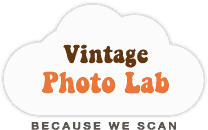Interview: Vintage Photo Lab
Photos are treasured pieces of our personal histories that have the power to bring back old experiences. At the same time, most people have these treasures stuffed into boxes at the back of a closet that are only dug out when the occasion demands. Reliving past memories shouldn’t be a chore. We spoke with a man who’s made it his mission to ensure your old photos and memories are more accessible and safer than ever by converting them to digital copies. In our interview, Ed Padmore, founder of Vintage Photo Lab, talks about his motivations for leaving his career in IT to start his own business and the kinds of customers and projects he’s encountered along the way.
ST: To start, could you talk a little bit about your background and what led you to start Vintage Photo Lab?
EP: I’d been trying to make a photo book for my gran and found it really difficult to find a good company to scan all her old photos. I tried doing some on a flatbed at home and realised pretty quickly that that wasn’t an option! After researching it, I decided I could develop a service that offered a really quick, easy and hassle free way to scan people’s photos throughout the UK.
At the time I was working in corporate IT and although I really enjoyed parts of what I did I always knew I wanted to work for myself eventually. I guess my gran’s photos helped me reach a tipping point – though she’d probably be slightly concerned to know she’s personally responsible for my ditching a ‘proper’ job!
ST: What do you find is the most common motivation for someone seeking your services?
EP: First and foremost, people want to make sure their photographic memories are preserved. There are a massive number of printed photos out there that are so precious to people because they hold family stories and memories that are waiting to be revisited or told for the first time. People are looking to unlock those and share them with family, friends and the world. Sharing at family parties is a big motivation as well – for example, slideshows of embarrassing old photos at a birthday or reunion or humiliating grooms at weddings!
Another common reason is that many people are looking to make books. Photo books are so popular these days and people have thousands of photos in their pockets, on their phones and also on their PCs and tablets that can be easily made into beautifully printed books, which are another great way to share pictures.
ST: What types of customers do you usually get? Has any customer stood out for their photos or their purpose for digitising?
EP: Customers are very varied. Initially, I was surprised at how many amazing old family photos people have. Photos from the 60s, 70s and 80s are most common but I’ve been amazed at the quality and age of some images – sometimes we receive photos from the early 1900s. Clearly, cameras were not very common then but that means people didn’t take throw away selfies or photos of food! The physical quality and content quality of these rare old photos is sometimes extraordinary. Especially interesting are the travel photos from that age. Travel was an incredible luxury then and you can really recognise that comparing the photos from then to photos now.
ST: What kinds of photos do you usually receive? Family photos? Photography projects? Other?
EP: It’s mainly family photos. Occasionally we have photography enthusiasts or professional photographers from various industries with specialist collections, e.g. portraits or landscapes, cars, industry. Once you get to the 80s, and certainly the 90s, cameras were more common and there are a lot more drunken nights, package holidays and ‘less composed’ subject matter – think naked streaking and drunken fancy dress!
ST: Have you had any unusual or interesting customer experiences?
EP: One customer was expecting their sister back from an extended stay abroad and decided to welcome them home, at the airport, with a childhood photo of them, printed onto a massive duvet cover. Not sure where that idea came from or how it went but they seemed pretty excited about it!
ST: What advice (aside from packing directions) would you give to someone wanting to have this service done? Anything they can do beforehand to make the process easier?
EP: First, be aware of just how many photos you have. People are often surprised how many old photos they actually have in their family. The average home in the UK has 4,000 photos sat in a dusty box somewhere. It’s frightening when you think how vulnerable they are – people say their photos are the first thing they’d save from a fire, but just digitising them is a lot safer all round.
Second, some people spend ages sorting through them but they soon learn that that takes hours. Once you place an order on our website, we do the rest. We collect, we return and obviously, we scan. You don’t need to do anything – just pop your box in one of our collection bags. Then when you have them back digitally you can share them, upload them, store them online, share with an aunty in Australia or just email them to old friends to embarrass them! It’s quite liberating having an old photo digitised and ready to share via the click of a mouse.
Visit Vintage Photo Lab to get started!



